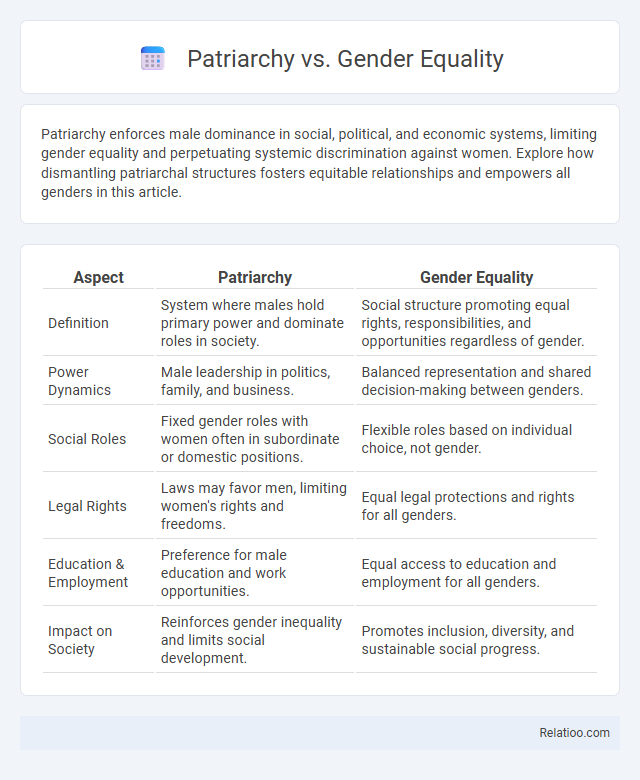Patriarchy enforces male dominance in social, political, and economic systems, limiting gender equality and perpetuating systemic discrimination against women. Explore how dismantling patriarchal structures fosters equitable relationships and empowers all genders in this article.
Table of Comparison
| Aspect | Patriarchy | Gender Equality |
|---|---|---|
| Definition | System where males hold primary power and dominate roles in society. | Social structure promoting equal rights, responsibilities, and opportunities regardless of gender. |
| Power Dynamics | Male leadership in politics, family, and business. | Balanced representation and shared decision-making between genders. |
| Social Roles | Fixed gender roles with women often in subordinate or domestic positions. | Flexible roles based on individual choice, not gender. |
| Legal Rights | Laws may favor men, limiting women's rights and freedoms. | Equal legal protections and rights for all genders. |
| Education & Employment | Preference for male education and work opportunities. | Equal access to education and employment for all genders. |
| Impact on Society | Reinforces gender inequality and limits social development. | Promotes inclusion, diversity, and sustainable social progress. |
Understanding Patriarchy: Definition and Historical Context
Patriarchy is a social system where men hold primary power in roles of political leadership, moral authority, and control of property, deeply rooted in historical contexts across many cultures. Understanding patriarchy involves recognizing its origins in ancient societies where male dominance was institutionalized, shaping gender roles and societal hierarchies. This framework contrasts sharply with gender equality, which seeks to dismantle these power imbalances and promote equal rights and opportunities regardless of gender.
The Roots and Impact of Patriarchal Systems
Patriarchal systems, rooted in historical power structures that privilege male dominance, shape societal norms and roles, often leading to systemic gender inequalities. These systems affect various aspects of life including political representation, economic opportunities, and social expectations, resulting in unequal access to resources and power for women and marginalized genders. Challenging patriarchy through gender equality initiatives promotes social justice, economic development, and healthier communities by fostering equal rights, opportunities, and respect across all genders.
What Is Gender Equality? Principles and Importance
Gender equality refers to the state in which individuals of all genders have equal rights, responsibilities, and opportunities across social, economic, and political spheres. It is grounded in principles of fairness, non-discrimination, and respect for human rights, promoting access to education, employment, and representation regardless of gender. Achieving gender equality is crucial for sustainable development, poverty reduction, and the realization of inclusive societies where everyone can contribute and thrive equally.
Social Structures: How Patriarchy Shapes Institutions
Patriarchy profoundly shapes social institutions by reinforcing male dominance and preserving gender hierarchies through laws, education, and workplace norms. Social structures under patriarchy often marginalize women's voices and limit access to resources, perpetuating inequality across generations. Gender equality challenges these entrenched power dynamics by advocating for inclusive policies that dismantle discriminatory practices and promote equal participation in all societal sectors.
Gender Equality Movements: Global Milestones and Progress
Gender equality movements have achieved significant global milestones such as the adoption of the Universal Declaration of Human Rights in 1948 and the establishment of the Convention on the Elimination of All Forms of Discrimination Against Women (CEDAW) in 1979. Landmark progress includes increased female representation in political offices, legal reforms promoting equal pay, and expanded access to education for girls worldwide. These movements continue to challenge patriarchal structures by advocating for gender equity in social, economic, and political spheres across diverse cultures.
Effects of Patriarchy on Women, Men, and Non-Binary People
Patriarchy systematically enforces gender hierarchies, resulting in unequal power dynamics that disproportionately limit women's access to education, career opportunities, and political representation. Men often experience pressured adherence to traditional masculinity, leading to emotional suppression and societal expectations that constrain personal expression. Non-binary individuals face heightened marginalization under patriarchal norms, encountering erasure, discrimination, and limited recognition of their identities in social, legal, and institutional contexts.
Overcoming Barriers: Strategies for Achieving Gender Equality
Overcoming barriers to gender equality requires dismantling patriarchal structures that enforce rigid gender roles and limit opportunities for marginalized groups. Your organization can implement inclusive policies, promote education on gender sensitivity, and foster environments that value diverse voices and perspectives. Empowering individuals through leadership development and equitable resource distribution helps create sustainable change toward a gender-equal society.
Legal and Policy Approaches to Dismantling Patriarchy
Legal and policy approaches to dismantling patriarchy focus on enacting gender equality laws that challenge systemic discrimination and promote equal rights in areas such as employment, education, and political participation. You benefit from reforms like affirmative action, anti-discrimination statutes, and family law changes that protect women's rights and redistribute power more equitably. Enforcing these policies requires monitoring mechanisms and legal literacy initiatives to ensure that patriarchal norms do not undermine progress toward gender equality.
The Role of Education in Promoting Gender Equality
Education plays a crucial role in dismantling patriarchy by challenging traditional gender roles and promoting critical thinking about equality. Your access to gender-sensitive curricula and inclusive learning environments fosters awareness and respect for diverse identities, empowering individuals to advocate for equal rights. Schools and educational institutions act as pivotal platforms for cultivating gender equality, reshaping societal norms, and inspiring future generations to reject discriminatory systems.
Future Perspectives: Toward an Inclusive and Equitable Society
Future perspectives on patriarchy versus gender equality emphasize dismantling systemic barriers to create an inclusive and equitable society where diverse identities are respected and empowered. Your role in advocating for policy reforms and education that challenge traditional gender norms is crucial to achieving sustainable progress. Embracing intersectionality and promoting equal opportunities across all social, economic, and political spheres will shape a fairer future for all genders.

Infographic: Patriarchy vs Gender Equality
 relatioo.com
relatioo.com